Abstract
Race is an unscientific, societally constructed taxonomy that is based on an ideology that views some human population groups as inherently superior to others on the basis of external physical characteristics or geographic origin. The concept of race is socially meaningful but of limited biological significance. Racial or ethnic variations in health status result primarily from variations among races in exposure or vulnerability to behavioral, psychosocial, material, and environmental risk factors and resources. Additional data that capture the specific factors that contribute to group differences in disease must be collected. However, reductions in racial disparities in health will ultimately require change in the larger societal institutions and structures that determine exposure to pathogenic conditions. More attention needs to be given to the ways that racism, in its multiple forms, affects health status. Socio-economic status is a central determinant of health status, overlaps the concept of race, but is not equivalent to race. Inadequate attention has been given to the range of variation in social, cultural, and health characteristics within and between racial or ethnic minority populations. There is a growing emphasis, both within and without the Federal Government, on the collection of racial or ethnic identifiers in health data systems, but noncoverage of the Asian and Pacific Islander population, Native Americans, and subgroups of the Hispanic population is still a major problem. However, for all racial or ethnic groups, we need not only more data but better data. We must be more active in directly measuring the health-related aspects of belonging to these social categories.
Full text
PDF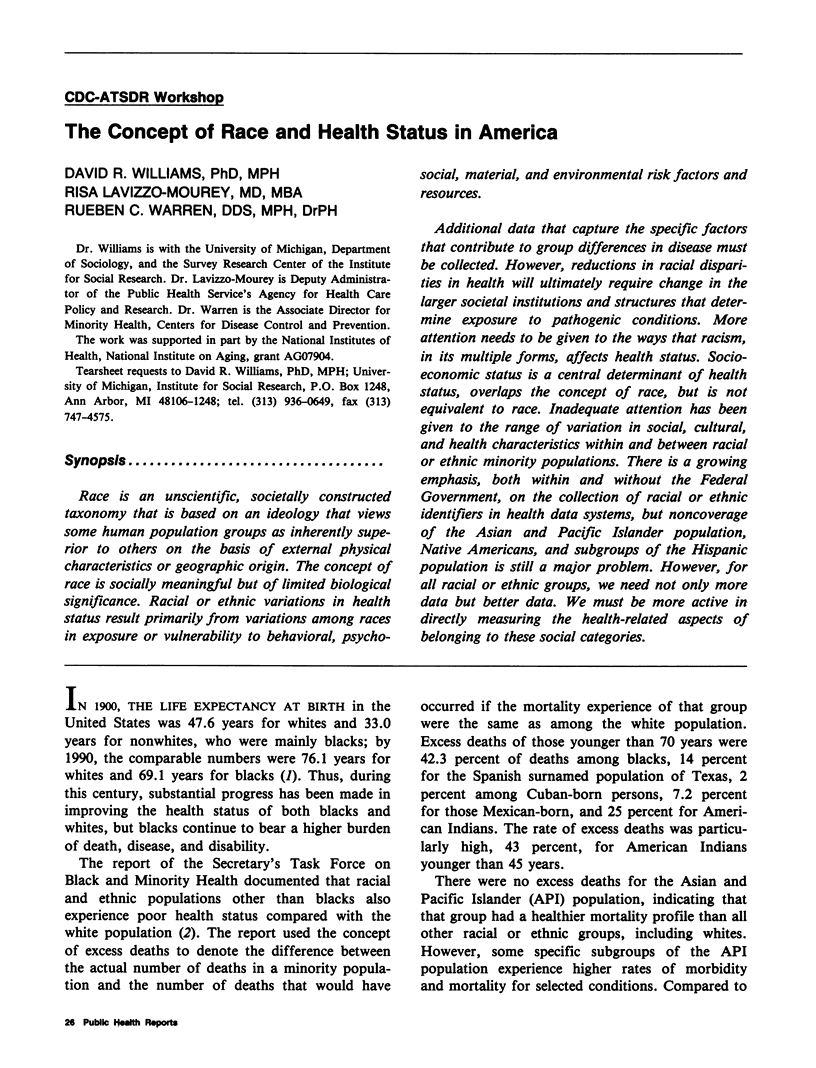


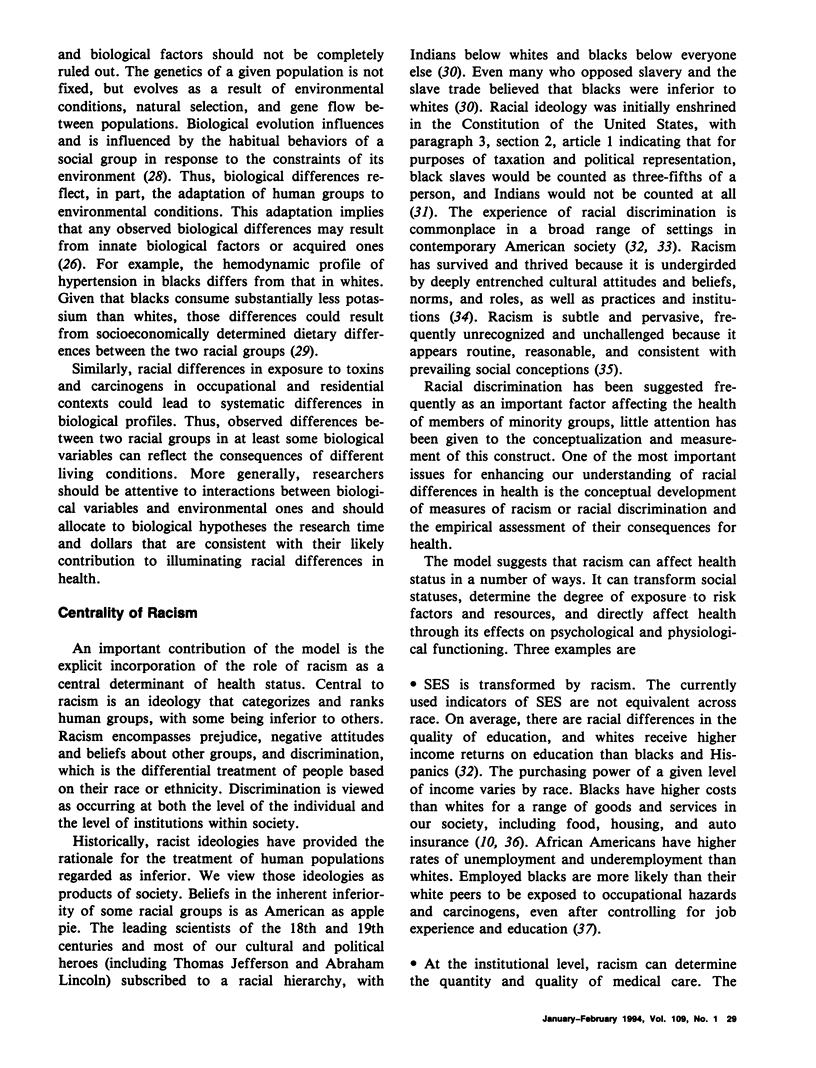
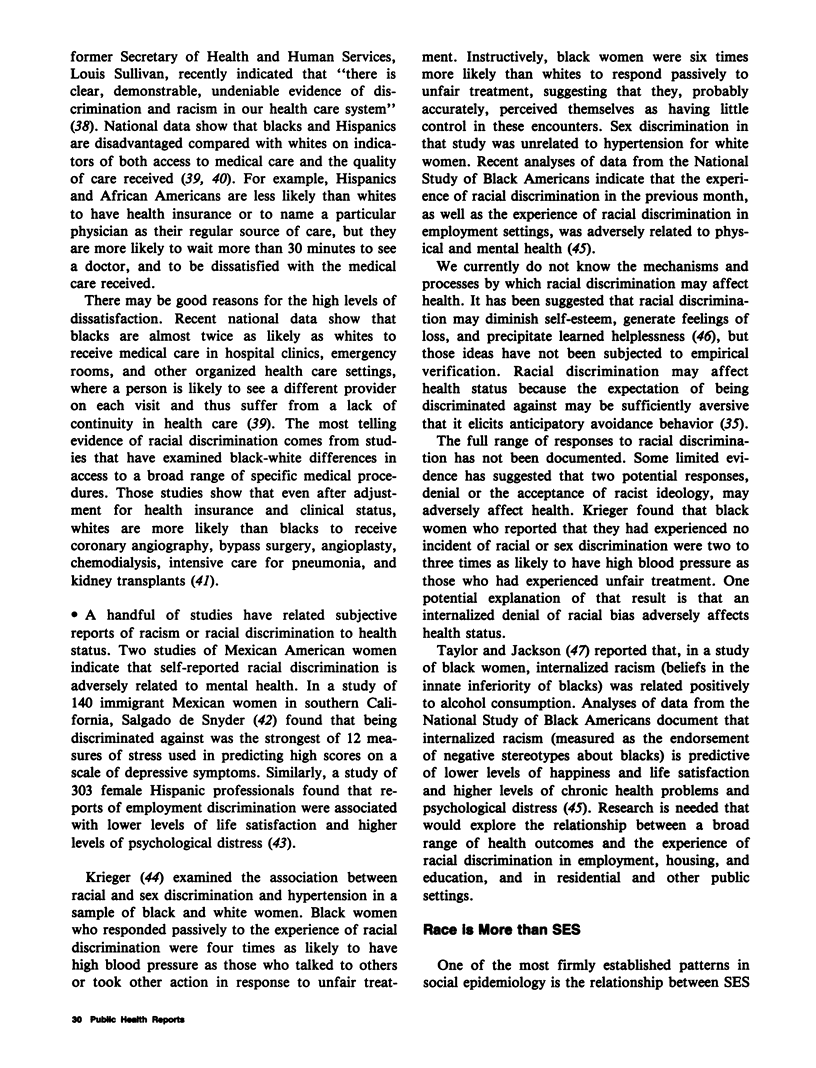
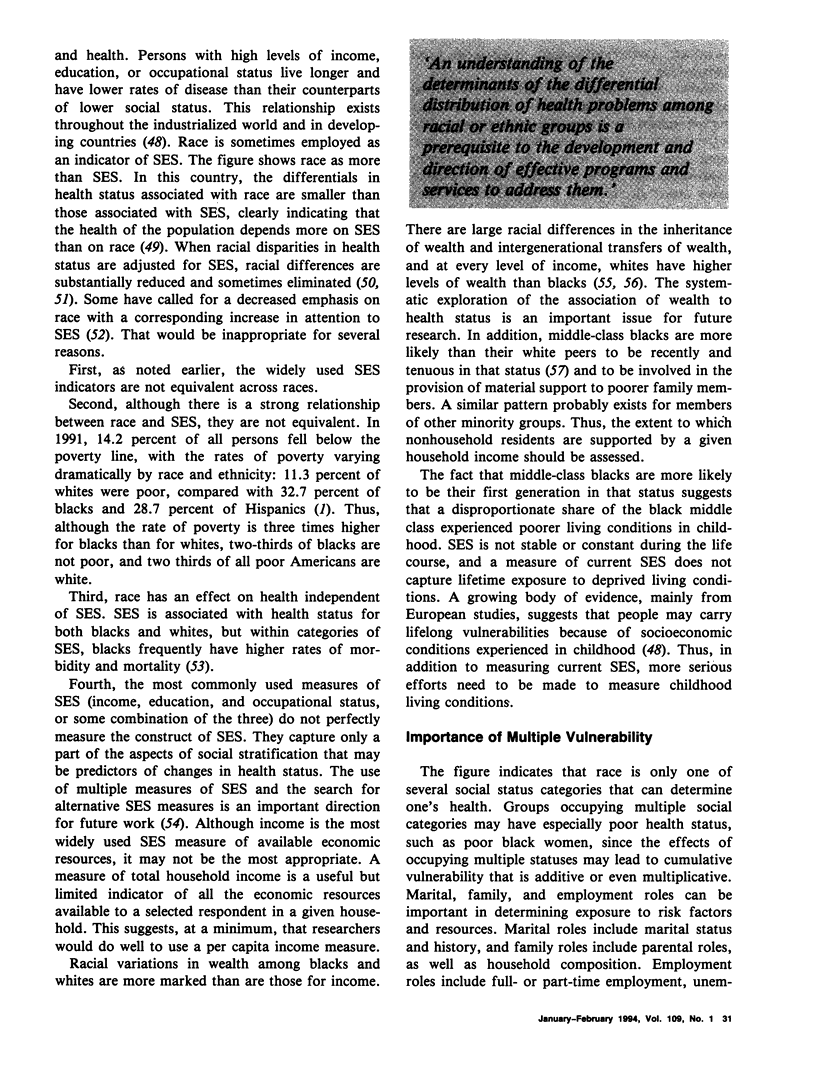
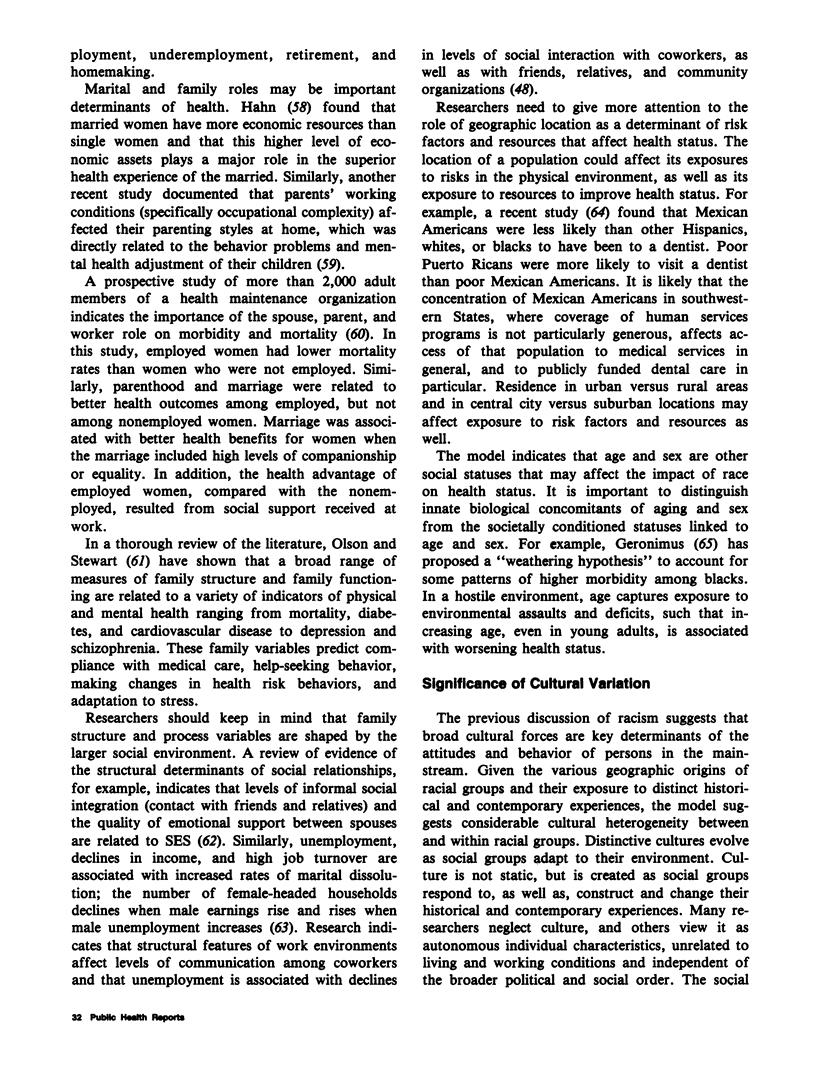


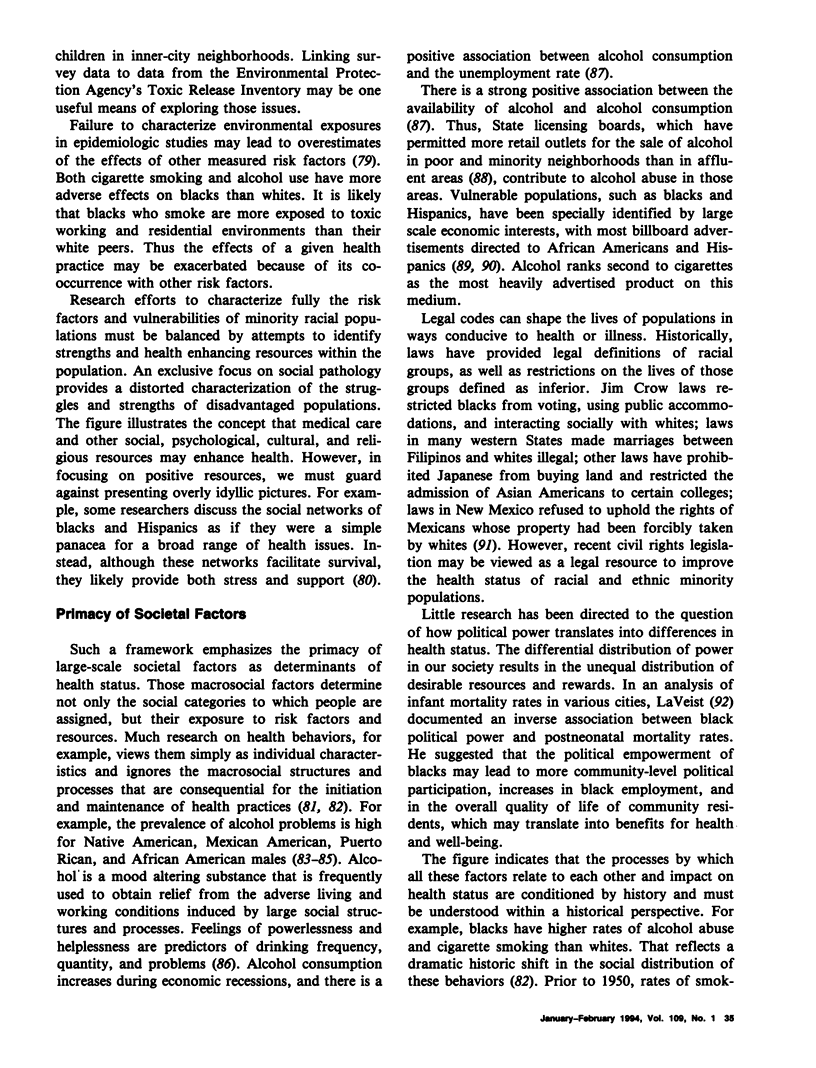


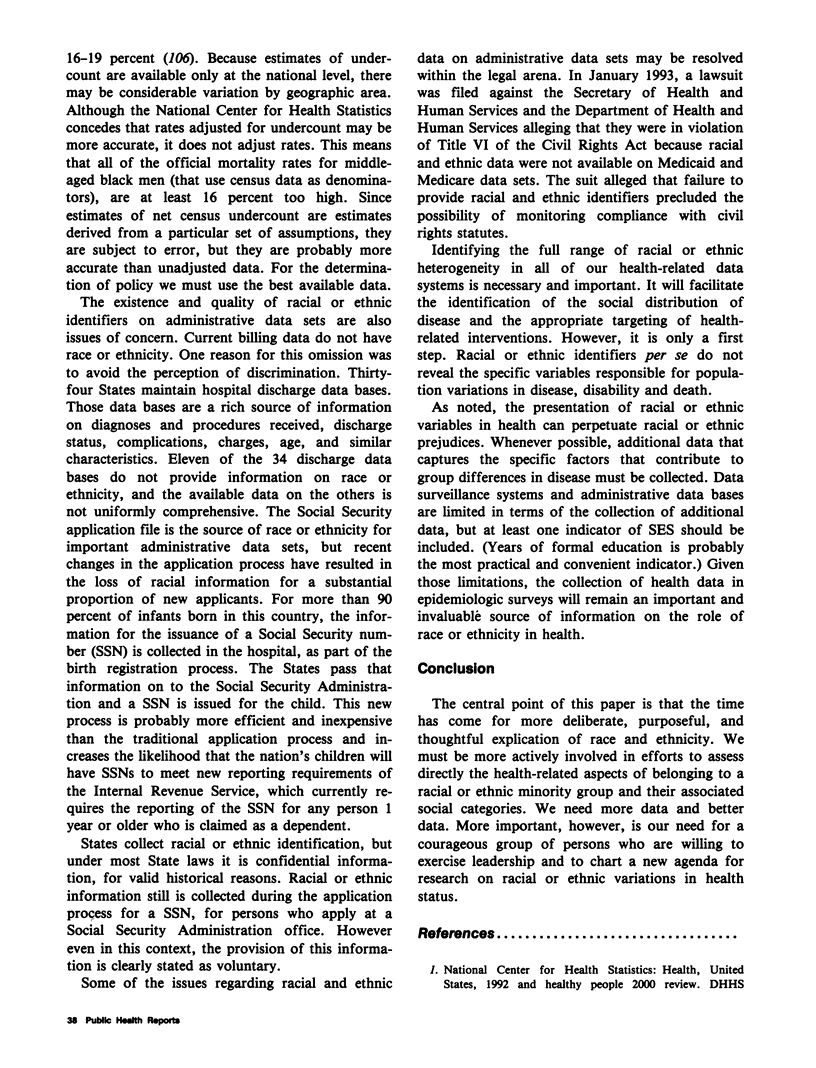

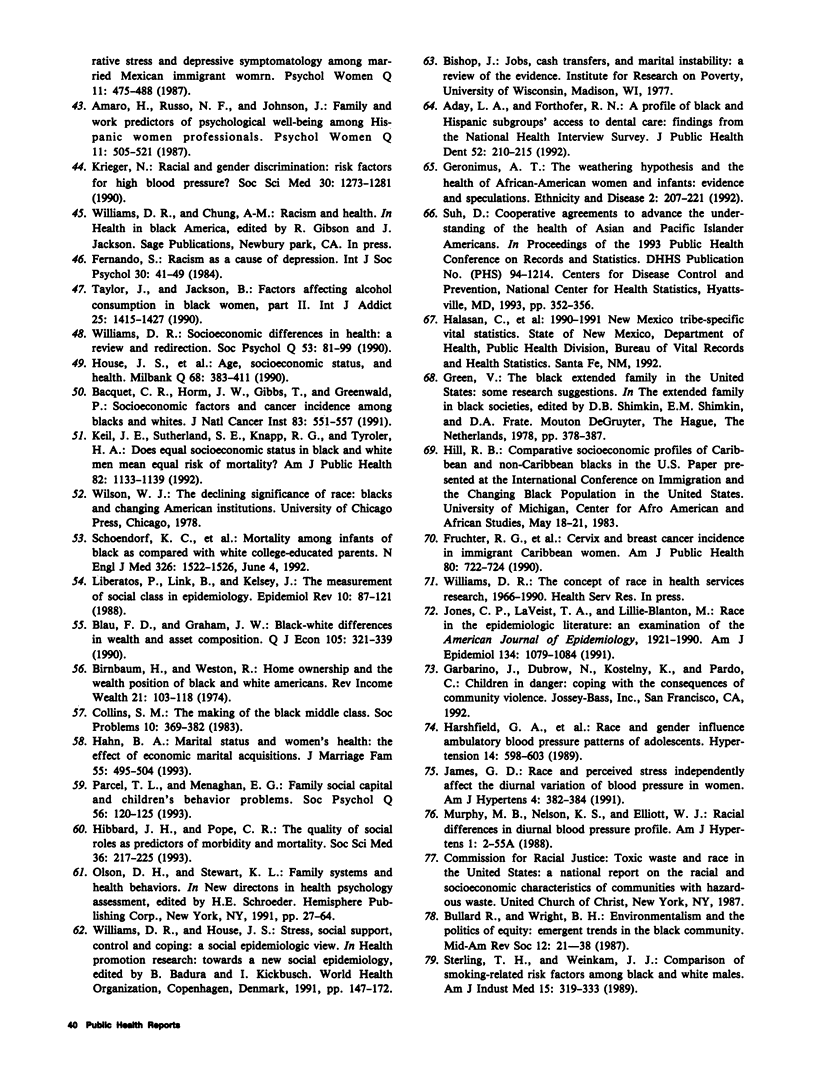

Selected References
These references are in PubMed. This may not be the complete list of references from this article.
- Aday L. A., Forthofer R. N. A profile of black and Hispanic subgroups' access to dental care: findings from the National Health Interview Survey. J Public Health Dent. 1992 Summer;52(4):210–215. doi: 10.1111/j.1752-7325.1992.tb02275.x. [DOI] [PubMed] [Google Scholar]
- Andersen R. M., Giachello A. L., Aday L. A. Access of Hispanics to health care and cuts in services: a state-of-the-art overview. Public Health Rep. 1986 May-Jun;101(3):238–252. [PMC free article] [PubMed] [Google Scholar]
- Baquet C. R., Horm J. W., Gibbs T., Greenwald P. Socioeconomic factors and cancer incidence among blacks and whites. J Natl Cancer Inst. 1991 Apr 17;83(8):551–557. doi: 10.1093/jnci/83.8.551. [DOI] [PubMed] [Google Scholar]
- Blendon R. J., Aiken L. H., Freeman H. E., Corey C. R. Access to medical care for black and white Americans. A matter of continuing concern. JAMA. 1989 Jan 13;261(2):278–281. [PubMed] [Google Scholar]
- Brandt A. M. Racism and research: the case of the Tuskegee Syphilis Study. Hastings Cent Rep. 1978 Dec;8(6):21–29. [PubMed] [Google Scholar]
- Brown S. A., Hutchinson R., Morrisett J., Boerwinkle E., Davis C. E., Gotto A. M., Jr, Patsch W. Plasma lipid, lipoprotein cholesterol, and apoprotein distributions in selected US communities. The Atherosclerosis Risk in Communities (ARIC) Study. Arterioscler Thromb. 1993 Aug;13(8):1139–1158. doi: 10.1161/01.atv.13.8.1139. [DOI] [PubMed] [Google Scholar]
- Caruso-Nicoletti M., Mancuso M., Spadaro G., Samperi P., Consalvo C., Schilirò G. Growth and development in white patients with sickle cell diseases. Am J Pediatr Hematol Oncol. 1992 Nov;14(4):285–288. [PubMed] [Google Scholar]
- Cooper R. A note on the biologic concept of race and its application in epidemiologic research. Am Heart J. 1984 Sep;108(3 Pt 2):715–722. doi: 10.1016/0002-8703(84)90662-8. [DOI] [PubMed] [Google Scholar]
- Cooper R., David R. The biological concept of race and its application to public health and epidemiology. J Health Polit Policy Law. 1986 Spring;11(1):97–116. doi: 10.1215/03616878-11-1-97. [DOI] [PubMed] [Google Scholar]
- Frost F., Taylor V., Fries E. Racial misclassification of Native Americans in a surveillance, epidemiology, and end results cancer registry. J Natl Cancer Inst. 1992 Jun 17;84(12):957–962. doi: 10.1093/jnci/84.12.957. [DOI] [PubMed] [Google Scholar]
- Fruchter R. G., Nayeri K., Remy J. C., Wright C., Feldman J. G., Boyce J. G., Burnett W. S. Cervix and breast cancer incidence in immigrant Caribbean women. Am J Public Health. 1990 Jun;80(6):722–724. doi: 10.2105/ajph.80.6.722. [DOI] [PMC free article] [PubMed] [Google Scholar]
- Geronimus A. T. The weathering hypothesis and the health of African-American women and infants: evidence and speculations. Ethn Dis. 1992 Summer;2(3):207–221. [PubMed] [Google Scholar]
- Harshfield G. A., Alpert B. S., Willey E. S., Somes G. W., Murphy J. K., Dupaul L. M. Race and gender influence ambulatory blood pressure patterns of adolescents. Hypertension. 1989 Dec;14(6):598–603. doi: 10.1161/01.hyp.14.6.598. [DOI] [PubMed] [Google Scholar]
- Hayes-Bautista D. E., Chapa J. Latino terminology: conceptual bases for standardized terminology. Am J Public Health. 1987 Jan;77(1):61–68. doi: 10.2105/ajph.77.1.61. [DOI] [PMC free article] [PubMed] [Google Scholar]
- Herd D. Migration, cultural transformation and the rise of black liver cirrhosis mortality. Br J Addict. 1985 Dec;80(4):397–410. doi: 10.1111/j.1360-0443.1985.tb03011.x. [DOI] [PubMed] [Google Scholar]
- Hibbard J. H., Pope C. R. The quality of social roles as predictors of morbidity and mortality. Soc Sci Med. 1993 Feb;36(3):217–225. doi: 10.1016/0277-9536(93)90005-o. [DOI] [PubMed] [Google Scholar]
- House J. S., Kessler R. C., Herzog A. R. Age, socioeconomic status, and health. Milbank Q. 1990;68(3):383–411. [PubMed] [Google Scholar]
- Howard B. V., Welty T. K., Fabsitz R. R., Cowan L. D., Oopik A. J., Le N. A., Yeh J., Savage P. J., Lee E. T. Risk factors for coronary heart disease in diabetic and nondiabetic Native Americans. The Strong Heart Study. Diabetes. 1992 Oct;41 (Suppl 2):4–11. doi: 10.2337/diab.41.2.s4. [DOI] [PubMed] [Google Scholar]
- Jackson F. L. Race and ethnicity as biological constructs. Ethn Dis. 1992 Spring;2(2):120–125. [PubMed] [Google Scholar]
- James G. D. Race and perceived stress independently affect the diurnal variation of blood pressure in women. Am J Hypertens. 1991 Apr;4(4 Pt 1):382–384. doi: 10.1093/ajh/4.4.382. [DOI] [PubMed] [Google Scholar]
- Jones C. P., LaVeist T. A., Lillie-Blanton M. "Race" in the epidemiologic literature: an examination of the American Journal of Epidemiology, 1921-1990. Am J Epidemiol. 1991 Nov 15;134(10):1079–1084. doi: 10.1093/oxfordjournals.aje.a116011. [DOI] [PubMed] [Google Scholar]
- Keil J. E., Sutherland S. E., Knapp R. G., Tyroler H. A. Does equal socioeconomic status in black and white men mean equal risk of mortality? Am J Public Health. 1992 Aug;82(8):1133–1136. doi: 10.2105/ajph.82.8.1133. [DOI] [PMC free article] [PubMed] [Google Scholar]
- Krieger N. Racial and gender discrimination: risk factors for high blood pressure? Soc Sci Med. 1990;30(12):1273–1281. doi: 10.1016/0277-9536(90)90307-e. [DOI] [PubMed] [Google Scholar]
- Krieger N. Shades of difference: theoretical underpinnings of the medical controversy on black/white differences in the United States, 1830-1870. Int J Health Serv. 1987;17(2):259–278. doi: 10.2190/DBY6-VDQ8-HME8-ME3R. [DOI] [PubMed] [Google Scholar]
- Levine D. M., Becker D. M., Bone L. R., Stillman F. A., Tuggle M. B., 2nd, Prentice M., Carter J., Filippeli J. A partnership with minority populations: a community model of effectiveness research. Ethn Dis. 1992 Summer;2(3):296–305. [PubMed] [Google Scholar]
- Liberatos P., Link B. G., Kelsey J. L. The measurement of social class in epidemiology. Epidemiol Rev. 1988;10:87–121. doi: 10.1093/oxfordjournals.epirev.a036030. [DOI] [PubMed] [Google Scholar]
- Lillie-Blanton M., Anthony J. C., Schuster C. R. Probing the meaning of racial/ethnic group comparisons in crack cocaine smoking. JAMA. 1993 Feb 24;269(8):993–997. [PubMed] [Google Scholar]
- McGraw S. A., McKinlay J. B., Crawford S. A., Costa L. A., Cohen D. L. Health survey methods with minority populations: some lessons from recent experience. Ethn Dis. 1992 Summer;2(3):273–287. [PubMed] [Google Scholar]
- Rabow J., Watts R. K. Alcohol availability, alcoholic beverage sales and alcohol-related problems. J Stud Alcohol. 1982 Jul;43(7):767–801. doi: 10.15288/jsa.1982.43.767. [DOI] [PubMed] [Google Scholar]
- Richie J. P., Kerr W. S., Jr Sickle cell trait: forgotten cause of hematuria in white patients. J Urol. 1979 Jul;122(1):134–135. doi: 10.1016/s0022-5347(17)56287-4. [DOI] [PubMed] [Google Scholar]
- Robinson J. C. Racial inequality and the probability of occupation-related injury or illness. Milbank Mem Fund Q Health Soc. 1984 Fall;62(4):567–590. [PubMed] [Google Scholar]
- Schoendorf K. C., Hogue C. J., Kleinman J. C., Rowley D. Mortality among infants of black as compared with white college-educated parents. N Engl J Med. 1992 Jun 4;326(23):1522–1526. doi: 10.1056/NEJM199206043262303. [DOI] [PubMed] [Google Scholar]
- Seeman M., Anderson C. S. Alienation and alcohol: the role of work, mastery, and community in drinking behavior. Am Sociol Rev. 1983 Feb;48(1):60–77. [PubMed] [Google Scholar]
- Singer M. Toward a political-economy of alcoholism: the missing link in the anthropology of drinking. Soc Sci Med. 1986;23(2):113–130. doi: 10.1016/0277-9536(86)90360-6. [DOI] [PubMed] [Google Scholar]
- Sterling T. D., Weinkam J. J. Comparison of smoking-related risk factors among black and white males. Am J Ind Med. 1989;15(3):319–333. doi: 10.1002/ajim.4700150307. [DOI] [PubMed] [Google Scholar]
- Taylor J., Jackson B. Factors affecting alcohol consumption in black women. Part II. Int J Addict. 1990 Dec;25(12):1415–1427. doi: 10.3109/10826089009056228. [DOI] [PubMed] [Google Scholar]
- Treviño F. M. Standardized terminology for hispanic populations. Am J Public Health. 1987 Jan;77(1):69–72. doi: 10.2105/ajph.77.1.69. [DOI] [PMC free article] [PubMed] [Google Scholar]
- Waldman H. B. "Rediscovering" the health status of Native Americans. ASDC J Dent Child. 1992 May-Jun;59(3):216–220. [PubMed] [Google Scholar]
- Williams D. R. Black-White differences in blood pressure: the role of social factors. Ethn Dis. 1992 Spring;2(2):126–141. [PubMed] [Google Scholar]


